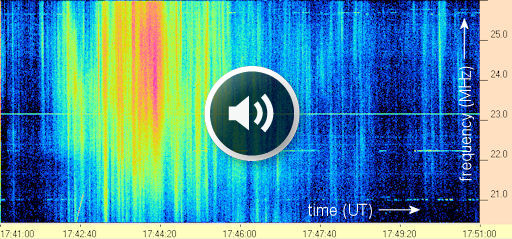GEOMAGNETIC STORM UNDERWAY: A moderate G2-class geomagnetic storm is underway following the arrival of a CME on March 12th at ~0930 UT. The CME's impact caused strong ground currents in Norway. At the same time, photographic Southern Lights were recorded over New Zealand and Tasmania. High-latitude sky watchers should be alert for auroras. Aurora alerts: text, phone.
WEEKEND SOLAR FLARE: Sunspot AR1429 erupted again over the weekend. On Saturday, March 10th, it produced a powerful M8-class flare that almost crossed the threshold into X-territory. During the flare, New Mexico amateur astronomer Thomas Ashcraft recorded a series of radio bursts at 21 and 28 MHz:

Dynamic spectrum courtesy Wes Greenman, Alachua County, Florida
The roaring sounds you just heard are caused by shock waves plowing through the sun's atmosphere in the aftermath of the explosion. "There is incredible complexity in the waveforms," notes Ashcraft. "This is a recording of one of the most turbulent events in all of Nature!"
In addition, the explosion propelled yet another CME toward Earth. According to a forecast track prepared by analysts at the Goddard Space Weather Lab, the cloud will hit our planet's magnetosphere on March 12th at 1803 UT (+/- 7 hr), possibly sparking a new round of geomagnetic storms.
After passing Earth, the CME will also hit the Mars Science Lab (MSL) spacecraft on March 13th followed by Mars itself on March 14th. Mars rover Curiosity onboard MSL might get some interesting readings as the cloud passes by.
SUNSET PLANETS: This is a great week to admire the sunset. Venus and Jupiter are side-by-side only 3o apart in the western sky, beaming through the twilight as soon as the sun goes down. "We have a wild tree in our front yard just begging for a set of eyes," says photographer Jeff Brown of Selah, Washington. "Jupiter and Venus worked perfectly." (continued below)
The two bright planets seem to inspire photographic creativity. In Wiltshire, England, Richard Fleet measured their angular separation using a pair of cat's ears, while photographer Claus Vogel of Ottawa, Ontario, tried his hand at planet painting.
Let the planets be your muse, and submit your images here.
more images: from Chad Blakley of Abisko National Park, Sweden; from Göran Strand of Frösön, Sweden; from Gary A. Becker of Coopersburg, PA; from Andrew Dianetti of Paris, France; from Andrew Hoggins of Knowlton Dorset UK; from P-M Hedén of Stockholm, Sweden; from Barbara L. Schumacher of Vista, California.

![]()
Solar wind
speed: 501.3 km/sec
density: 0.7 protons/cm3
explanation | more data
Updated: Today at 1545 UT
![]()
X-ray Solar Flares
6-hr max: C1 1209 UT Mar12
24-hr: C2 0155 UT Mar12
explanation | more data
Updated: Today at: 1500 UT
![]()
![]()
![]()
Daily Sun: 12 Mar 12
![]()
![]()
Sunspot 1429 is starting to decay as it turns away from Earth. The 'spot poses a declining threat for Earth-directed flares. Credit: SDO/HMI
![]()
![]()
![]()
Sunspot number: 103
What is the sunspot number?
Updated 11 Mar 2012
Spotless Days
Current Stretch: 0 days
2012 total: 0 days (0%)
2011 total: 2 days (<1%)
2010 total: 51 days (14%)
2009 total: 260 days (71%)
Since 2004: 821 days
Typical Solar Min: 486 days
Updated 11 Mar 2012
The Radio Sun
10.7 cm flux: 131 sfu
explanation | more data
Updated 11 Mar 2012
![]()
![]()
![]()
Current Auroral Oval:
![]()
Switch to: Europe, USA, New Zealand, Antarctica
Credit: NOAA/POES
![]()
![]()
![]()
Planetary K-index
Now: Kp= 6 storm
24-hr max: Kp= 6 storm
explanation | more data
![]()
Interplanetary Mag. Field
Btotal: 13.7 nT
Bz: 2 nT south
explanation | more data
Updated: Today at 1546 UT
![]()
![]()
![]()
Coronal Holes: 12 Mar 12
![]()
![]()
A solar wind stream flowing from this coronal hole could reach Earth on March 16-17. Credit: SDO/AIA.





